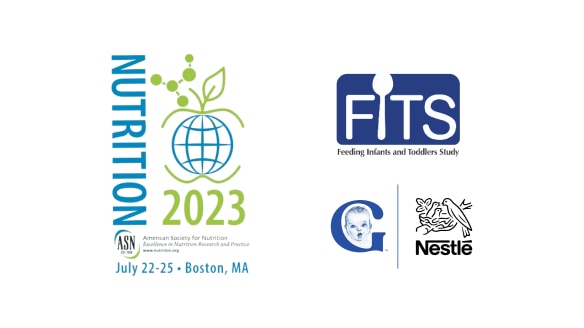Eating Occasion Frequency for Infants & Young Children
4 min read • By: Lyndsey R. Huss1, Susan Pac1, Alison L. Eldridge2, Cheryl Callen1
1Gerber Products Company, Nestlé Nutrition; 2Nestlé Nestlé Research VCLB, Switzerland

Quick summary
At the American Society for Nutrition Conference, Gerber presented their poster for a study on infant and young child eating patterns. Using data from FITS, they concluded infants and young children have more frequent meals and snacks when compared to older children and adults.
Eating occasion frequency study
Background
For adults and children ≥ 4 years of age, the FDA considers a typical dietary pattern to be four eating occasions per day (three meals, one snack). This informs criteria for select nutrition related claims where daily recommended amounts of nutrients of food components are divided by eating occasions per day to determine a significant amount. Different dietary patterns, eating occasions, and recommendations for infants and young children would impact criteria for younger age groups.
Objective
Evaluate the number of eating occasions per day for infants and young children <4y.
Methods
FITS (Anater 2018) is a large national cross sectional survey of children ≤4y (n=3235)
Food and beverage intake was assessed using 24-hour dietary recalls for infants and children ages 6-11.9, 12-23.9 and 24-47.9 months old.
Percent consuming by eating occasion (i.e., infant feedings (breastmilk and/or formula), meals, and snacks) as well as number of eating occasions per day (mean ± standard error) were calculated
Results
Approximately half of the daily energy for infants 6-11.9 months is from infant feeding occasions (breastmilk and/or formula), 3.57 times per day.
In addition, infants were fed 4.37 times (comprised of two meals and two snack occasions).

By 12 months, virtually all young children had an established pattern of three meals plus three snack occasions.
Young children 12-23.9 months old had 6.65 eating occasions/day (three meals, three snack occasions) comparable to children 24-47.9 months (6.15 eating occasions/day: three meals, three snack occasions).

1Meals include breakfast, lunch, and dinner
2Includes all breast feeding or infant formula feeding occasions, regardless of the respondent's assignment as a meal or non-meal
3Includes foods and beverages other than breast milk or infant formula
Conclusions
FITS shows that infants and young children have more frequent daily meal and snack occasions than older children and adults.
These findings are consistent with NHANES (Barrera 2019), showing 5.3 eating occasions per day in 1–4-year-olds.
Age-specific dietary patterns for infants and young children should be considered when developing age-appropriate requirements for nutrition related claims, such as “healthy.”
Practice Applications
The number of eating occasions by infants and young children differs from that of older children and adults in that infants and young children eat smaller quantities and eat more frequently.
These findings are consistent with NHANES (Barrera 2019) and AAP patterns (AAP 2008) of children aged 1 to 4 consuming three meals and two to three snacks per day.
As young children transition from milk feedings to a pattern more typical to adults, health care professionals should be aware that this is a demanding in-between phase in which physically intimate feeding moments are replaced by complementary foods and table foods along with new types of foods being introduced. Parents’ full attention and awareness towards their child’s reactions may be warranted (Norlyk 2019).
This may support public health efforts to identify the best intervention points for programs and policies aimed at improving the diets of infants and young children (Barrera 2019).



